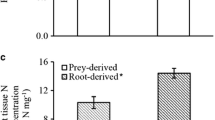Abstract
We report the use of stable isotope and crop content analyses to quantify the use of saguaro (Carnegiea gigantea) nectar and fruit by migratory desert white-winged doves (Zenaida asiatica mearsnii). Saguaro resources had characteristically 13C-enriched CAM values (δ13C=–12.8±0.7‰ SD VPDB and –13.1±0.5‰ SD VPDB for nectar and fruit, respectively) relative to other food plants used by doves (δ13CC3=–24.9±3.3‰ SD VPDB). The water contained in saguaro nectar and fruit was deuterium enriched (δD=19.6±2.0‰ SD VSMOW and 48.4±1.6‰ SD VSMOW for nectar and fruit, respectively) relative to other water sources (ranging from –41 to –19‰ VSMOW). During the fruiting season, there was a positive correlation between δ13C in dove liver tissues and percent of saguaro in crop contents. A two-point mixing model indicated that during the peak of saguaro fruit use, most of the carbon incorporated in dove tissues was from saguaro. Desert white-winged doves appear to be saguaro specialists. Averaged over the period when doves were resident, saguaro comprised about 60% of the total carbon incorporated into dove tissues. Tissue δ13C and δD of body water showed a significant positive correlation, indicating that doves were using saguaro as a source of both nutrients and water. However, at the peak of saguaro utilization, the doves’ body-water δD was more positive (by about 20‰) than saguaro fruit water. We hypothesize that this enrichment is due to fractionated evaporative water losses by doves. Using dove carbon isotope data and a two end-point mixing model we estimate that, on average, doves consume the equivalent of 128 saguaro fruits per season; each fruit contains on average 26.0±14.8 g SD of pulp (wet mass) of which 19.4 g is water. Stable isotopes have been used to produce qualitative re-constructions of animal diets. Our study shows that they can be used to provide quantitative estimates of the flow of nutrients from resources into consumers as well.
Similar content being viewed by others
Author information
Authors and Affiliations
Additional information
Received: 30 September 1999 / Accepted: 23 March 2000
Rights and permissions
About this article
Cite this article
Wolf, B., Martinez del Rio, C. Use of saguaro fruit by white-winged doves: isotopic evidence of a tight ecological association. Oecologia 124, 536–543 (2000). https://doi.org/10.1007/s004420000406
Issue Date:
DOI: https://doi.org/10.1007/s004420000406




